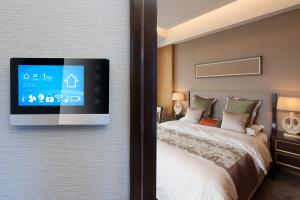Automatic Shades, Smart Windows & Lighting: How the Gulf-Coast Climate Demands Smarter Design
Smart systems react faster than any person could, keeping spaces consistent while minimizing strain on other systems”
SLIDELL, LA, UNITED STATES, November 13, 2025 /EINPresswire.com/ -- In the Gulf South, where humidity, heat, and storms define much of the year, home and commercial design continues to evolve. The rise of automatic shading systems, adaptive windows, and intelligent lighting has become more than a matter of convenience—it’s a response to the region’s demanding environment.— Don Tucker
According to Don Tucker, owner of D&D Audio and Video Solutions in Slidell, Louisiana, technology-driven building systems are no longer a luxury but an essential part of efficient living and working spaces. “Homes and businesses across the Gulf Coast face constant challenges from sunlight, temperature, and moisture,” Tucker said. “Smarter design allows those factors to be managed automatically instead of manually.”
Climate as a Design Challenge
The Gulf Coast climate is unlike that of any other region in the country. Long, hot summers combine with high humidity and intense UV exposure. Afternoon storms arrive suddenly, and temperature fluctuations can be extreme. Traditional shading and lighting approaches often fail to adapt to these shifts, forcing residents and business owners to rely heavily on cooling systems and artificial lighting.
Automatic shades and smart window technologies have emerged as solutions tailored to these challenges. Sensors monitor outdoor conditions and adjust shade positions or glass opacity to maintain indoor comfort. This real-time adjustment keeps spaces cooler during peak sunlight hours and preserves natural light during cloudy conditions.
In a region where air conditioning represents a major portion of energy use, systems that reduce solar gain without sacrificing brightness can lead to significant efficiency improvements.
The Science Behind Automatic Shading
Automatic shades operate through a network of sensors and controllers that track sunlight intensity, temperature, and even time of day. When direct sunlight begins to heat a room, the shades automatically lower to block thermal buildup. As the sun shifts or clouds pass, they raise again to allow daylight back in.
This constant fine-tuning creates balance within a space. Instead of battling the environment with mechanical cooling, design technology works in harmony with it. The system doesn’t simply open and close—it responds dynamically, maintaining consistent indoor comfort through automation rather than human adjustment.
For the Gulf Coast, that adaptability translates into tangible benefits. Homes stay cooler. Energy systems operate more efficiently. Materials inside—such as flooring, furniture, and artwork—avoid the fading and heat damage often caused by prolonged sun exposure.
Smart Windows as an Active Barrier
Smart glass, sometimes known as electrochromic or dynamic glazing, adds another dimension to energy-conscious design. The technology allows the tint level of the window itself to shift electronically, blocking or permitting light based on environmental conditions.
When heat and brightness rise, the glass darkens, reducing glare and limiting heat transfer. During cooler or overcast periods, it clears again, allowing warmth and brightness back inside. Unlike traditional coatings or films, this adjustment happens automatically, requiring no manual control.
In a coastal setting, this technology plays an important role in comfort and preservation. By regulating temperature and reducing UV exposure, smart windows help protect interior finishes and maintain stable indoor conditions even during peak heat.
Tucker noted that the technology aligns naturally with Gulf Coast building needs. “The climate here doesn’t remain steady,” he said. “Smart systems react faster than any person could, keeping spaces consistent while minimizing strain on other systems.”
Intelligent Lighting in a Changing Environment
Lighting control has also become part of this integrated design movement. Automated lighting systems use occupancy sensors, timers, and daylight monitoring to adjust interior illumination in real time. When natural daylight increases, artificial lighting fades or shuts off entirely. As the sun sets, the lighting gradually restores, maintaining a balanced environment without energy waste.
In humid, storm-prone climates, where natural light changes rapidly throughout the day, automated lighting ensures consistent comfort without constant adjustment. It also supports energy management by reducing unnecessary consumption during periods of strong daylight.
Beyond energy concerns, proper lighting design influences circadian rhythm and overall wellness. By adjusting brightness and color temperature throughout the day, intelligent systems help align indoor spaces with natural environmental cycles—something that standard fixtures cannot replicate.
Integration and Control
The true strength of modern environmental systems lies in integration. Automatic shades, smart windows, and lighting controls no longer function independently. Through centralized automation platforms, they communicate seamlessly with HVAC, humidity control, and even storm-preparation systems.
For example, when sensors detect rising afternoon heat, shades can lower, glass can darken, and cooling systems can scale back simultaneously. When a storm approaches, windows and shading systems can enter protective modes automatically, preserving structural integrity and reducing risk.
These systems can also be scheduled or programmed to accommodate individual patterns. Morning routines, work hours, and nighttime settings can all be configured into a single, unified control platform. This approach not only enhances comfort but ensures consistency across all building systems.
Building for Longevity
Coastal conditions demand resilience, and intelligent design contributes directly to the longevity of buildings. By managing light, temperature, and humidity proactively, automated systems reduce stress on infrastructure. Mechanical components—such as air conditioning units and ventilation systems—operate more efficiently and last longer when not forced to overcompensate for environmental extremes.
Materials inside the structure also benefit. Reduced UV exposure prevents fading, cracking, and warping. Lower humidity levels protect electronics, furniture, and finishes. The entire building ecosystem operates under more balanced conditions, which helps preserve both function and value over time.
A Smarter Future for the Gulf South
The evolution of building automation marks a turning point for coastal living and working environments. Technology that once seemed futuristic has become a practical necessity for adapting to local conditions. Automatic shades, adaptive glass, and responsive lighting now form the foundation of energy-conscious, sustainable design across the Gulf region.
In an area known for heat, storms, and shifting light, the capacity to adapt automatically has become essential. Intelligent systems allow buildings to respond to nature’s rhythm instead of resisting it.
As more homes and businesses embrace this model, the Gulf Coast continues to demonstrate how regional challenges can drive innovation. The climate remains demanding, but technology has finally caught up with its pace—creating environments that endure, adapt, and function with balance in every season.
Morgan Thomas
Rhino Digital, LLC
+1 504-875-5036
email us here
Visit us on social media:
Facebook
Legal Disclaimer:
EIN Presswire provides this news content "as is" without warranty of any kind. We do not accept any responsibility or liability for the accuracy, content, images, videos, licenses, completeness, legality, or reliability of the information contained in this article. If you have any complaints or copyright issues related to this article, kindly contact the author above.


